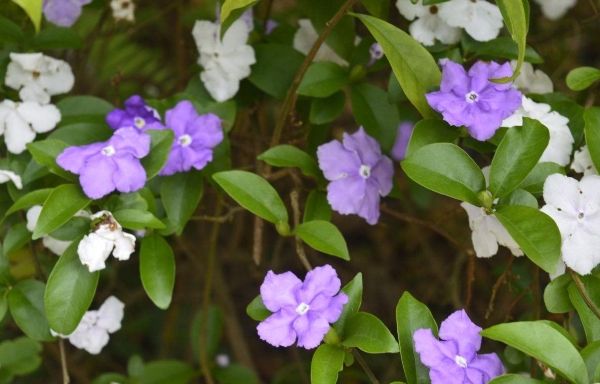Matters needing attention in the culture of Eleurotus angustifolia
1. Pruning
When the plant growth is too prosperous, the dense leaves need to be removed to improve the ventilation and light transmission conditions, and the dead leaves should be removed in time to keep the plant shape beautiful.

two。 Turn the basin
The purple leaf grass grows rapidly, so it should be turned over once a year in spring to replace the new fertile and suitable soil in time.
3. Fertilizer application
The bottom fertilizer should be applied when the purple leaf grass is cultured in the basin, and the nitrogen, phosphorus and potassium compound fertilizer can be applied once a month during the growing period. the fertilizer concentration should not be too high, and do not apply a single fertilizer, otherwise it will affect the plant growth.
The above is the cultivation method of purple leaf sorrel brought to you by the editor, hoping to help you raise a beautiful purple leaf sorrel.
How to cultivate Oxalis purpurea how to cultivate the propagation mode of Oxalis purpurea
Purple leaf sorrel, also known as red leaf sorrel, triangular sorrel, purple leaf mountain this grass, perennial root herbs, flowering from April to November. Name: acid pulp, trefolic acid, triangular acid, sour mother, vinegar mother, acid loop, dodecanoic acid, Finch grass, small sour grass, red sun Shi, porphyrin acid, tricfolic acid. The fruit is a capsule. The fruit will crack automatically when it is ripe and should be picked in time. Flowers and leaves are sensitive to light. Open on sunny days and close at night and when there is not enough light on cloudy days. Like a warm and humid environment. Grow exuberantly in the rich, moist soil, and the leaves are enlarged. More hardy, the winter temperature is not lower than 0 ℃.
Morphological characteristics of Oxalis purpurea
Perennial perennial root herb, root system is translucent fleshy root, bifurcated, light brown, the lower part has a little whisker root, the root tip is planted in the underground stem, the underground stem is composed of scales, and the underground stem forms branches in the underground and is distributed in coral shape.
The leaves of Oxalis sorrel grow from the top of the stem, and each leaf is connected to every scale of the underground stem. Leaves are Ternate palmately compound leaves, clustered, born at the top of the petiole, leaflet petiole is very short, isosceles triangular, born on the total petiole, the total petiole is 15-31 cm long. The leaves are rosy red on the front and irregular light rose spots in the middle, extending to the two edges of the leaves. The back of the leaf is crimson and shiny. Generally spread out during the day, drooping in strong light and dusk, the three leaves are close to each other, especially like dancing butterflies, planted under the sparse forest, the leaves spread all day long, the leaf color is quite bright.
The flowers of Elaeagnus angustifolia are umbels, light pink, with 5 petals and 8 flowers clustered at the top of the stem. The flower stem is slender, 14-20 cm, swaying with the wind, graceful. One to several umbels that form axils. Sepals oblong. The top is sharp. Pilose; petals Obovate, slightly revolute; filaments basally connate to form a tube.
The capsule of Elaeagnus angustifolia is nearly columnar. 5-angled. Have short hairs. Eject the seeds when they mature and crack. Seeds small, oblate-ovate, reddish brown, horizontally grooved.
The flowering and fruiting period of Oxalis purpurea is from March to August.
Ecological habits of Oxalis purpurea
Eleurotus angustifolia is suitable for loose soil with good drainage, likes light and is resistant to semi-shade, and its flowering period is as long as 8 months. No disease and insect harm, during the period of high temperature and humidity, the old leaf is easy to suffer from gray mold, but does not affect the new leaf, the extremely purple leaf is easy to control. More hardy, evergreen in winter above-5 ℃, leaves withered in the aboveground part below-5 ℃, but not dead in the underground part, and new leaves can germinate again in March of the following year. There is no obvious dormancy period, and the cultivation management is extensive.
Cultivation techniques of Oxalis purpurea
The propagation of Elaeagnus angustifolia is mainly ramet, and it can also be sowed or propagated by tissue culture. Herbs perennial, persistent, bulbous, covered with black-brown scales, globular buds from the scales, agglomerated into clusters, the lower part of the bulb with fusiform tuberous roots, translucent.
The Propagation Mode of Elaeagnus angustifolia
Ramet propagation
It can be carried out all the year round, and the ramet from April to May in spring is the best, ramet propagation, that is, the division of bulbs, can be carried out all the year round.
Tissue culture propagation
When dividing the plant, dig up the plant first, break the corm and plant it, or cut the bulb into small pieces, leaving more than 3 bud holes in each small piece, put them into a sand bed for cultivation, grow new plants in about 15 days, and then transplant them after rooting and spreading leaves.
Sowing and reproduction
The reproduction is sown in the pot in spring, and the suitable temperature for germination is 15-18 degrees. It germinated about 15 days after sowing, and the seedlings could blossom for viewing in that year.
The growing period requires that the light should not be too strong, otherwise the color of the leaves is dim. Maintain high air humidity, pay attention to avoid soil contamination of leaves when watering, affecting the ornamental effect. Fertilize once a month. The light orientation of the blade is strong, and the position of the basin needs to be changed frequently. It needs to be replanted and renewed every year.
Distribution area of Oxalis purpurea
Purple leaf sorrel prairie is produced in South America and Brazil. Mexico is a rare and excellent ground cover plant with colorful leaves. It has been successfully introduced in our country.
After reading the above introduction on how to cultivate sorrel, do you know more about it? if you want to know more about Oxalis, please continue to pay attention.
How to split purple leaf sorrel how to propagate purple leaf sorrel
Purple leaf sorrel, also known as purple sorrel, is a beautiful ornamental plant, many people like breeding, but do you know how to divide the purple leaf sorrel? Do you know the propagation method of Oxalis purpurea? If you don't understand, you can go and have a look with the editor.
How to split purple leaf sorrel how to propagate purple leaf sorrel
1. How to split the purple leaf grass
At ordinary times, there are many ways when the purple leaf sorrel is divided into many plants. people can divide its phosphorus stem directly, the mother ball can be divided into several bulbs, and the new balls produced on its stems can be directly divided into new plants and planted in other flowerpots. In addition, when it is divided into plants, the stem can be separated, and the bottom of the stem can easily survive only if there is a root ball at the bottom.
2. How to propagate Elymus angustifolia
There are two methods of breeding purple leaf sorrel, one is to divide the ball to propagate, which is what people usually call ramets, and the other is to propagate by hand, which is relatively simple and has a high success rate. The stem reproduction is mostly used for some new varieties that do not bear balls. When the stem is propagated, its branches can be cut off and inserted directly into the soil. After more than ten days, it can grow new roots, and then transplant into the flowerpot.
3. Elaeagnus officinalis has a high demand for fertilizer.
At ordinary times, when you breed or split a plant, you must pay attention to the supply of fertilizer. In the basin soil, sufficient base fertilizer should be applied, such as bean cake or bone meal, which are all ideal choices for base fertilizer. In addition, after Oxalis entered the peak growing season, it is best to top fertilizer in time. It is best to top fertilizer every ten days, and the fertilizer is best to choose a compound fertilizer with a higher content of phosphorus and potassium than Luo.
- Prev

Matters needing attention in culturing bicolor jasmine
Bicolor jasmine likes the sunny environment, but can not be exposed to the sun, because excessive exposure can easily lead to the withering of flowers and leaves, so it is best to keep the light for 4 hours a day. And in order to keep the air moist, spray water on the leaves, keep the basin soil dry in winter, and reduce watering in the rainy season.
- Next

The fengshui effect of banyan bonsai
1. Dignitaries: the banyan tree is regarded as the king of the tree, so it can be seen that its fengshui function is very powerful. the leaves mean that the banyan tree represents the rich and powerful, which is also helpful to the rich and powerful spirit of the owner of the house. so many people like to raise their own banyan tree in the office, which will be helpful to their own fortune.
Related
- Fuxing push coffee new agricultural production and marketing class: lack of small-scale processing plants
- Jujube rice field leisure farm deep ploughing Yilan for five years to create a space for organic food and play
- Nongyu Farm-A trial of organic papaya for brave women with advanced technology
- Four points for attention in the prevention and control of diseases and insect pests of edible fungi
- How to add nutrient solution to Edible Fungi
- Is there any good way to control edible fungus mites?
- Open Inoculation Technology of Edible Fungi
- Is there any clever way to use fertilizer for edible fungus in winter?
- What agents are used to kill the pathogens of edible fungi in the mushroom shed?
- Rapid drying of Edible Fungi

